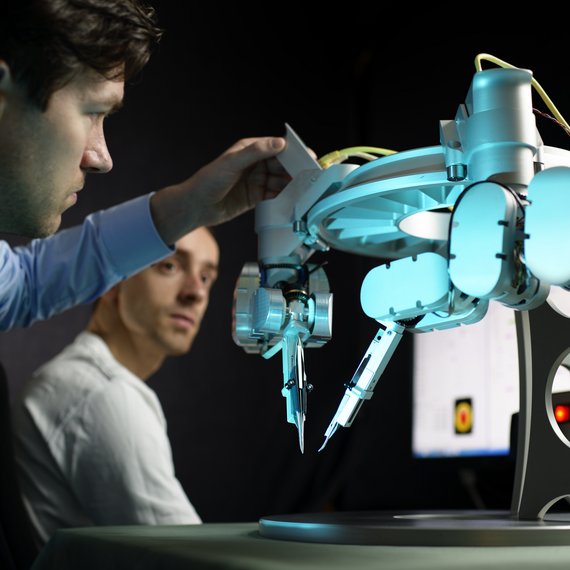Date
Thursday February 1, 2024 from 1:00 PM to 6:00 PMLocation
TU/e campus | Auditorium | Blauwe ZaalOrganizer
High Tech Systems CenterCo-organizer
VDL-ETGPrice
FreeBuilding
AuditoriumYou are welcome to join the VDL - HTSC mini symposium: Contamination Control
Program
12:30 Walk-in with coffee and tea at the Auditorium
13:00 Welcome by Ton Peijnenburg | CTO VDL-ETG
13:10 Introduction ACCESS project
Paul Blom | Sr. System Engineer at VDL-ETG
13:25 Particle creation
Towards understanding wear particle generation on silicon wafers | PhD candidate Sven Sperling and EngD candidate Tom Bertens
13:55 Particle transport
Thermophoretic force in a rarefied gas | PhD Candidate Ralf Reinartz
14:25 Coffee break
14:45 Particle removal
Plasma based dust filter | PhD candidate Judith van Huijstee
15:15 Conclusions ACCESS project
Kasper van den Broek | Tribology Expert & Contamination Control Architect
15:30 Coffee break and poster market
16:00 Official start ACCESS-2 project
with TU/e Rector Magnificus Silvia Lenaerts, and Geert Jakobs CEO of VDL-ETG
16:30 - 17:45 Drinks and poster market
Registration is required but free of charge.

SPEAKERS & ABSTRACTS
Tom Bertens | EngD candidate
Title: Particle creation | Towards understanding wear particle generation on silicon wafers
Abstract
In recent years, attention has been directed toward contamination sources originating from the contact between lithography machine components and mono-crystalline silicon wafers. This interaction has been identified as an instigator of the formation of wear particles. The primary objective of this research is to try and understand the complexities of the contact between the wafer and the machine. This part of the Active Contamination Control for Equipment and SubstrateS (ACCESS) project led to the presented Engineering Doctorate (EngD) project, which aims to characterize the silicon wafer-machine interaction on the micrometer level. A thorough examination through in-situ scratch experiments is conducted on the micro and nanometer scale. This involved the installation and mastery of the Pico-indenter 89 (PI-89) indentation and scratch device by Bruker Nano, the PI-89. In this presentation the results are shown.
The machine parts, coated in a Diamond-Like-Carbon (DLC) coating, exhibit surface irregularities known as asperities, identified through extensive Atomic Force Microscopy (AFM) and Scanning Electron Microscopy (SEM) techniques. Indentation tests are conducted with an indenter probe specifically manufactured to the asperity geometry, to assess the loading conditions under which phase transformations occur in the mono-crystalline silicon.
With insights into the silicon phase transformations during indentation testing, scratch testing commenced where the goal is to mimic the silicon wafer-machine interaction. Results indicate that plastic deformation increases with higher normal loads. The topography of these scratches are analyzed using AFM measurements.
The scratch topography was successfully compared to the numerical outcomes of a material scratch model developed as part of the Ph.D. work as part of the ACCESS project. The successful integration of experimental and numerical results holds promise for future collaborations within the ACCESS project.
Bio
Bachelor Mechanical Engineering Avans Breda, Pre-master TU/e, Master TU/e, EngD TU/e (9.5GPA). For my bachelor I created a calculation tool for determining the eigenfrequencies of mega yachts, my master focused on mechanics of materials with my engineering doctorate resulting in a research into the material behavior of silicon under nanoindentation and micro-scratch loading.
Ralf Reinartz | PhD Candidate
Title: Particle transport | Thermophoretic force in a rarefied gas
Abstract
In this contribution, we present results on the thermophoretic force, the force due to a temperature gradient, on a finite-size spherical particle in rarefied gas conditions.
Results are obtained using both experimental and numerical methods.
The influence of particle thermal conductivity and gas properties on the thermophoretic force are investigated.
Some illustrative details of the methods will be shown.
Comparisons between the two methods will be made, discussing the influence of particle properties like, shape and accommodation coefficients.
Bio
I started my bachelors in Applied Physics at the TU/e in 2014 and graduated in 2017.
I followed up with the Masters Applied Physics at the TU/e in 2017 and graduated in 2019.
I did an external internship at the University of Southampton in 2018. During this internship, I performed wind tunnel measurements to determine the drag of bio fouled ship hulls.
My master thesis concerned the effect of under-expanded jets on the atomization process of liquids.
I started my PhD project in 2019 and will finish in 2024.
The topic is micro-particle transport in rarefied gas conditions, as found in High-tech manufacturing systems.
Research is done using experimental and numerical methods to provide VDL-ETG insight and simplified transport models for their particle contamination efforts.
Judith van Huijstee | PhD Candidate
Title: Particle removal | Plasma based dust filter
Abstract
Dust particles, with sizes down to nano- or micrometers, form a serious issue as contaminants in many modern high-tech applications. Therefore, the development of effective cleaning and filtering methods is a highly relevant research topic. The focus of this project is fundamental research that is necessary for the development of a novel plasma based dust particle filter. Such a plasma based filter would take advantage of the property that dust particles become electrically charged when they are immersed in plasma. Electrically charged particles can then be filtered by application of an external electric field. The fundamental research in this project investigates the interaction between dust particles and afterglow plasmas, specifically the charging of dust in this type of plasmas, as the dust particle charge is a key parameter for the effectiveness of a plasma based dust filter.
Bio
I studied at TU/e, where I followed the bachelor and master's program Applied Physics. During the master's program, I specialized in plasma physics. Currently, I am in the last phase of my PhD, the topic of which is the interaction between dust particles and afterglow plasmas. This is a relevant subject for the development of a plasma based dust filter.
